The LC fiber optic adapters market is valued at USD 871.1 million in 2025 and is expected to reach USD 1,378.9 million by 2035, growing at a CAGR of 4.7%. From 2021 to 2025, the market grows steadily, from USD 692.4 million to USD 871.1 million, with annual increments through USD 724.9 million, 759.0 million, 794.6 million, and 832.0 million. This growth phase reflects increasing demand for fiber optic connectivity in telecom, data centers, and enterprise networks, as well as a rise in high-speed internet adoption and digitalization efforts.
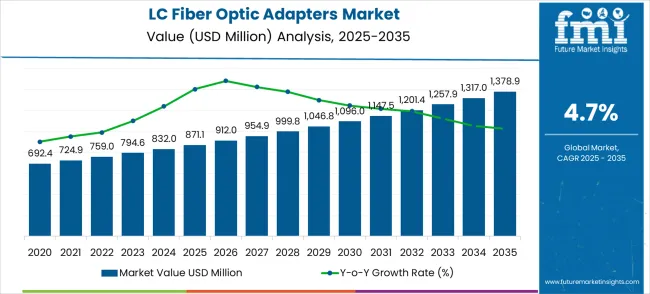
Between 2026 and 2030, the market continues to show solid growth, expanding from USD 912 million to USD 1,096.0 million. The intermediate years see gradual increases through USD 912.0 million, 954.9 million, 999.8 million, and 1,046.8 million. The surge in global broadband infrastructure expansion and the increasing deployment of 5G networks drive the demand for LC fiber optic adapters during this period. Between 2031 and 2035, the market reaches USD 1,378.9 million, with incremental growth through USD 1,147.5 million, 1,201.4 million, 1,257.9 million, and 1,317.0 million. The final years see the benefits of fiber optic advancements in high-capacity, low-latency data transmission, contributing to a steady growth trajectory.
| Metric | Value |
|---|---|
| Estimated Value in (2025E) | USD 871.1 million |
| Forecast Value in (2035F) | USD 1,378.9 million |
| Forecast CAGR (2025 to 2035) | 4.7% |
From 2030 to 2035, the market is forecast to grow from USD 1,096.0 million to USD 1,378.9 million, adding another USD 282.9 million, which constitutes 55.7% of the overall ten-year expansion. This period is expected to be characterized by the expansion of 5G network deployments and edge computing infrastructure, the development of advanced high-density connectivity solutions and ultra-low loss adapters, and the growth of specialized applications for cloud computing and artificial intelligence workloads. The growing adoption of hyperscale data centers and distributed network architectures will drive demand for LC fiber optic adapters with enhanced performance and scalability features.
Between 2020 and 2025, the LC fiber optic adapters market experienced steady growth, driven by increasing digital transformation initiatives and growing recognition of LC adapters as essential components for achieving high-density fiber optic connectivity and network performance optimization in modern telecommunications and data center infrastructure. The market developed as network engineers and data center architects recognized the potential for LC adapters to enable space-efficient connectivity while supporting high-speed data transmission and network scalability requirements. Technological advancement in fiber optic connector design and precision manufacturing began emphasizing the critical importance of maintaining signal integrity and connection reliability in high-performance network environments.
Market expansion is being supported by the increasing global demand for high-speed connectivity and the corresponding need for efficient fiber optic infrastructure that can support bandwidth-intensive applications, enable network scalability, and maintain signal integrity across various telecommunications, data center, and enterprise network applications. Modern network operators and infrastructure providers are increasingly focused on implementing connectivity solutions that can support growing data traffic, enable network densification, and provide reliable performance in demanding network environments. LC fiber optic adapters' proven ability to deliver high-density connectivity, maintain signal quality, and support network scalability makes them essential components for contemporary fiber optic networks and telecommunications infrastructure.
The growing focus on digital transformation and cloud computing is driving demand for LC fiber optic adapters that can support high-bandwidth applications, enable network optimization, and facilitate seamless connectivity in complex network architectures. Network providers' preference for connectivity solutions that combine high performance with space efficiency and installation simplicity is creating opportunities for innovative LC fiber optic adapter implementations. The rising influence of 5G networks and edge computing is also contributing to increased adoption of LC fiber optic adapters that can provide reliable connectivity without compromising network performance or scalability requirements.
The market is segmented by mode type, application, and region. By mode type, the market is divided into single-mode and multimode. Based on application, the market is categorized into data centers, telecommunications, industrial automation, and others. Regionally, the market is divided into Asia Pacific, North America, Europe, Latin America, and the Middle East & Africa.
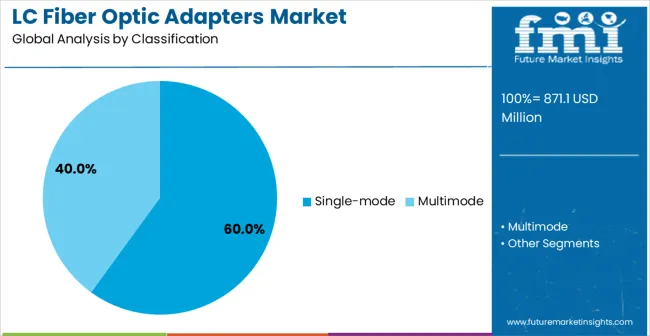
The single-mode segment is projected to maintain its leading position in the LC fiber optic adapters market in 2025, with a 60% market share. Network operators and telecommunications providers increasingly utilize single-mode LC adapters for their superior transmission characteristics, extended reach capabilities, and versatility across long-haul and metropolitan network configurations. Single-mode fiber technology offers proven performance advantages, providing high-bandwidth transmission and long-distance connectivity in diverse telecommunications and data center applications. As the backbone of modern fiber optic network infrastructure, single-mode fiber supports the highest bandwidth capacity and has an established performance record. Continued investments in single-mode fiber systems by network operators and data center providers further drive adoption, positioning these adapters as critical components for scalable, high-performance network strategies.
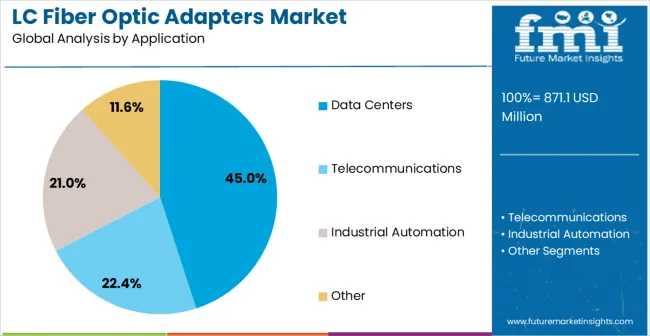
The data centers application segment is projected to represent the largest share of LC fiber optic adapter demand in 2025, capturing 45% of the market. Data center operators prefer LC fiber optic adapters due to their space-efficient design, high-density connectivity capabilities, and ability to support bandwidth-intensive applications. These adapters play a critical role in modern cloud computing facilities, hyperscale data centers, and enterprise server environments. The growing need for scalable network architectures and operational efficiency drives the demand for high-density connectivity solutions. The segment benefits from continuous innovations in data center technologies and specialized solutions that enhance network performance and scalability. As data centers evolve and bandwidth demands increase, the data center segment will remain a dominant driver of LC fiber optic adapter market growth, supporting advanced connectivity and infrastructure optimization strategies.
The LC fiber optic adapters market is advancing steadily due to increasing demand for high-speed connectivity and growing adoption of fiber optic infrastructure that provides enhanced bandwidth capacity and network performance across diverse telecommunications and data center applications. The market faces challenges, including intense price competition and margin pressure, technical requirements for precision manufacturing and quality control, and the need for compatibility with evolving network standards and connector technologies. Innovation in high-density connectivity solutions and advanced materials continues to influence product development and market expansion patterns.
The growing adoption of high-density connectivity technologies and advanced material innovations is enabling network providers to achieve superior space utilization, enhanced connection density, and improved signal performance for demanding network applications. High-density connectivity systems provide improved infrastructure efficiency while allowing more connections per unit area and consistent performance across various network configurations and application requirements. Manufacturers are increasingly recognizing the competitive advantages of high-density capabilities for infrastructure differentiation and space optimization.
Modern LC fiber optic adapter manufacturers are incorporating intelligent network management technologies and monitoring capabilities to enhance connection visibility, enable proactive maintenance, and provide comprehensive network performance optimization through integrated monitoring and management platforms. These technologies improve network reliability while enabling new applications, including predictive maintenance and automated network optimization. Advanced integration also allows network operators to support comprehensive infrastructure management and performance optimization beyond traditional passive connectivity approaches.
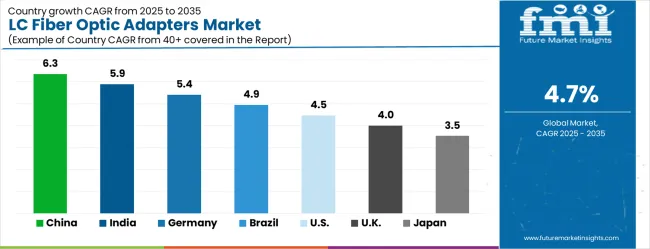
| Country | CAGR (2025-2035) |
|---|---|
| China | 6.3% |
| India | 5.9% |
| Germany | 5.4% |
| Brazil | 4.9% |
| USA | 4.5% |
| UK | 4.0% |
| Japan | 3.5% |
The LC fiber optic adapters market is experiencing solid growth globally, with China leading at a 6.3% CAGR through 2035, driven by the expanding telecommunications infrastructure, growing data center construction, and significant investment in 5G network deployment and fiber optic connectivity advancement. India follows at 5.9%, supported by rapid digitalization initiatives, increasing internet penetration, and growing adoption of fiber optic technologies in telecommunications and enterprise networks. Germany shows growth at 5.4%, emphasizing advanced network technologies and precision fiber optic component manufacturing. Brazil records 4.9%, focusing on telecommunications infrastructure modernization and data center expansion initiatives. The USA demonstrates 4.5% growth, supported by the established data center industry and focus on network infrastructure upgrades. The UK exhibits 4.0% growth, emphasizing telecommunications excellence and fiber optic network advancement. Japan shows 3.5% growth, supported by advanced networking technologies and precision connectivity component development.
The report covers an in-depth analysis of 40+ countries with top-performing countries highlighted below.
The LC fiber optic adapters market in China is expected to grow at a CAGR of 6.3% from 2025 to 2035. With the continuous expansion of China's telecommunications and data center industries, the demand for fiber optic components, including LC fiber optic adapters, is on the rise. The increasing digital transformation, adoption of 5G networks, and growth in cloud infrastructure require high-quality, reliable fiber optic adapters to support faster, more efficient communication. The rapid growth of Internet-of-Things (IoT) devices and the need for more efficient data transmission across various sectors such as healthcare, education, and government contribute to the market's growth. China’s leadership in manufacturing and technology innovation further supports the demand for fiber optic solutions, ensuring the country remains a key player in the global fiber optic adapter market.
Demand for LC fiber optic adapters in India is forecast to grow at a CAGR of 5.9% from 2025 to 2035. As the country continues to digitize its economy and improve its internet infrastructure, there is growing demand for fiber optic solutions, especially in sectors like telecommunications, data centers, and enterprise IT. The Indian government’s push to expand broadband connectivity and increase internet access in rural and remote areas is a major factor contributing to the market's expansion. The increasing number of cloud services, data storage requirements, and the adoption of 5G networks in India are further boosting the demand for fiber optic components like LC adapters.
LC fiber optic adapters market in Germany is expected to expand at a CAGR of 5.4% from 2025 to 2035. Germany, as a leading European economy, has a well-established telecommunications infrastructure that demands high-quality fiber optic components. The country's rapid adoption of 5G technology, coupled with its growing data center industry, is driving the need for efficient and reliable fiber optic solutions. Germany’s automotive industry, which is increasingly adopting connected vehicle technologies, also requires fast and reliable communication systems supported by fiber optics. As digital transformation continues across various sectors, including manufacturing and healthcare, the demand for LC fiber optic adapters will grow.
The LC fiber optic adapters market in Brazil is projected to grow at a CAGR of 4.9% from 2025 to 2035. As the largest economy in Latin America, Brazil is witnessing an increase in its telecommunications infrastructure to meet the growing demand for fast, reliable internet services. The government’s efforts to expand broadband connectivity and improve internet speeds, especially in underserved areas, are positively impacting the market. Brazil’s industrial sector, particularly in energy, manufacturing, and agriculture, is also adopting digital solutions that require high-performance fiber optic networks. The increasing usage of fiber optics in cloud computing and IoT applications is further driving the demand for LC fiber optic adapters.
The LC fiber optic adapters market in the USA is anticipated to grow at a CAGR of 4.5% from 2025 to 2035. The USA continues to be a major consumer of fiber optic technology due to its highly developed telecommunications, data center, and cloud industries. The demand for LC fiber optic adapters is driven by the need for faster internet speeds, lower latency, and efficient data transmission across various sectors, including government, healthcare, and financial services. The rapid expansion of 5G networks and IoT applications in the country is contributing to the demand for fiber optic components.
The LC fiber optic adapters market in the UK is forecasted to expand at a CAGR of 4.0% from 2025 to 2035. As the UK accelerates its digital transformation, the demand for reliable fiber optic solutions continues to increase. The government’s push to enhance broadband connectivity and the rapid rollout of 5G networks are key factors driving the market. The UK’s growing data center and cloud computing industries require high-performance fiber optic components, including LC adapters, to support their infrastructure. The demand for fiber optic solutions is also rising in sectors such as healthcare and education, where reliable, fast communication networks are critical.
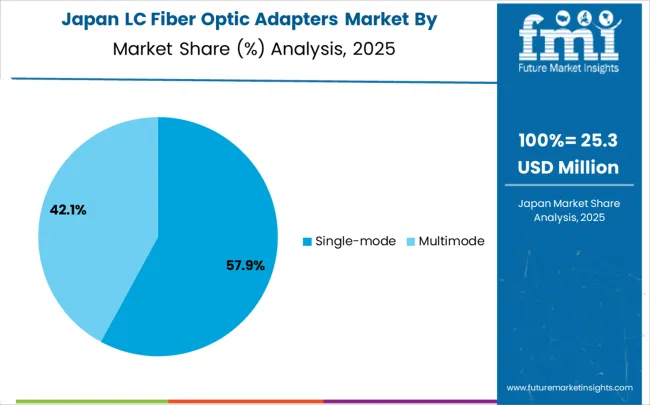
The LC fiber optic adapters market in Japan is expanding at a CAGR of 3.5% from 2025 to 2035. Known for its technological innovations, Japan is experiencing significant demand for fiber optic solutions, particularly in its telecommunications, automotive, and manufacturing sectors. The country’s commitment to expanding 5G networks and the increasing adoption of IoT applications are major contributors to the market’s growth. Japan’s focus on high-speed internet and low-latency communication is driving the need for efficient and reliable fiber optic adapters. As digitalization progresses in Japan, the demand for these components will continue to rise.
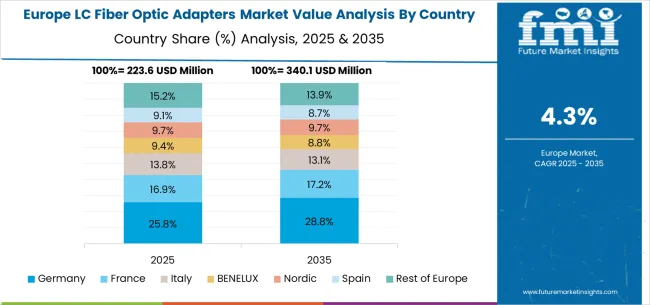
The LC fiber optic adapters market in Europe is projected to grow from USD 300.7 million in 2025 to USD 463.8 million by 2035, registering a CAGR of 4.4% over the forecast period. Germany is expected to maintain its leadership position with a 26.0% market share in 2025, moderating slightly to 25.8% by 2035, supported by its strong telecommunications sector, advanced network infrastructure, and comprehensive fiber optic connectivity ecosystem serving major European markets.
The United Kingdom follows with 21.0% in 2025, projected to reach 20.8% by 2035, driven by established telecommunications excellence, a comprehensive network modernization framework, and advanced connectivity infrastructure programs. France holds 18.5% in 2025, rising to 18.7% by 2035, supported by telecommunications infrastructure leadership and growing adoption of advanced fiber optic connectivity technologies. Italy commands 14.0% in 2025, projected to reach 14.1% by 2035, while Spain accounts for 9.0% in 2025, expected to reach 9.1% by 2035. The Netherlands maintains a 4.5% share in 2025, growing to 4.6% by 2035. The Rest of Europe region, including Nordic countries, Eastern Europe, and other markets, is anticipated to maintain its position, holding its collective share at 7.0% by 2035, attributed to increasing telecommunications modernization and growing fiber optic connectivity adoption across emerging network markets implementing advanced connectivity standards.
The LC fiber optic adapters market is characterized by competition among established telecommunications component manufacturers, specialized fiber optic connectivity companies, and integrated network solution providers. Companies are investing in advanced fiber optic technology research, precision manufacturing, quality assurance, and comprehensive product portfolios to deliver reliable, high-performance, and cost-effective LC fiber optic adapter solutions. Innovation in high-density connectivity, advanced materials, and precision manufacturing technologies is central to strengthening market position and competitive advantage.
Corning leads the market with comprehensive fiber optic solutions, offering advanced LC adapters with a focus on signal integrity and network performance optimization across diverse telecommunications and data center applications. SENKO Advanced Components provides specialized fiber optic connectivity products with an focus on precision manufacturing and high-density applications. Optcore delivers innovative connectivity solutions with a focus on data center and enterprise network requirements. Amphenol specializes in comprehensive connectivity technologies with focus on reliability and performance. Molex focuses on advanced connectivity solutions with focus on innovation and network optimization. Fibertronics offers specialized fiber optic products with a focus on precision and application versatility.
LC fiber optic adapters represent a critical connectivity component within telecommunications and data center infrastructure, projected to grow from USD 871.1 million in 2025 to USD 1,378.9 million by 2035 at a 4.7% CAGR. These precision-engineered connector interfaces-primarily single-mode configurations for long-distance, high-bandwidth applications-enable high-density fiber optic connections in data centers, telecommunications networks, and industrial automation systems. Market expansion is driven by accelerating data center construction, 5G network deployment, cloud computing infrastructure growth, and increasing demand for bandwidth-intensive applications requiring reliable, space-efficient connectivity solutions.
How Telecommunications Regulators Could Enhance Network Infrastructure Development?
How Industry Standards Organizations Could Advance Technology and Interoperability?
How Component Manufacturers Could Drive Innovation and Market Leadership?
How Data Center Operators Could Optimize Infrastructure Efficiency?
How Network Equipment Manufacturers Could Enhance System Integration?
How Investors and Financial Enablers Could Support Market Evolution?
| Items | Values |
|---|---|
| Quantitative Units (2025) | USD 871.1 million |
| Mode Type | Single-mode, Multimode |
| Application | Data Centers, Telecommunications, Industrial Automation, Others |
| Regions Covered | Asia Pacific, North America, Europe, Latin America, Middle East & Africa |
| Countries Covered | China, India, Germany, Brazil, the United States, the United Kingdom, Japan, and 40+ countries |
| Key Companies Profiled | Corning, SENKO Advanced Components, Optcore, Amphenol, Molex, and Fibertronics |
| Additional Attributes | Dollar sales by mode type and application category, regional demand trends, competitive landscape, technological advancements in fiber optic systems, high-density connectivity development, precision manufacturing innovation, and network performance optimization |
Asia Pacific
North America
Europe
Latin America
Middle East & Africa
The global LC fiber optic adapters market is estimated to be valued at USD 871.1 million in 2025.
The market size for the LC fiber optic adapters market is projected to reach USD 1,378.9 million by 2035.
The LC fiber optic adapters market is expected to grow at a 4.7% CAGR between 2025 and 2035.
The key product types in LC fiber optic adapters market are single-mode and multimode.
In terms of application, data centers segment to command 45.0% share in the LC fiber optic adapters market in 2025.






Our Research Products

The "Full Research Suite" delivers actionable market intel, deep dives on markets or technologies, so clients act faster, cut risk, and unlock growth.

The Leaderboard benchmarks and ranks top vendors, classifying them as Established Leaders, Leading Challengers, or Disruptors & Challengers.

Locates where complements amplify value and substitutes erode it, forecasting net impact by horizon

We deliver granular, decision-grade intel: market sizing, 5-year forecasts, pricing, adoption, usage, revenue, and operational KPIs—plus competitor tracking, regulation, and value chains—across 60 countries broadly.

Spot the shifts before they hit your P&L. We track inflection points, adoption curves, pricing moves, and ecosystem plays to show where demand is heading, why it is changing, and what to do next across high-growth markets and disruptive tech

Real-time reads of user behavior. We track shifting priorities, perceptions of today’s and next-gen services, and provider experience, then pace how fast tech moves from trial to adoption, blending buyer, consumer, and channel inputs with social signals (#WhySwitch, #UX).

Partner with our analyst team to build a custom report designed around your business priorities. From analysing market trends to assessing competitors or crafting bespoke datasets, we tailor insights to your needs.
Supplier Intelligence
Discovery & Profiling
Capacity & Footprint
Performance & Risk
Compliance & Governance
Commercial Readiness
Who Supplies Whom
Scorecards & Shortlists
Playbooks & Docs
Category Intelligence
Definition & Scope
Demand & Use Cases
Cost Drivers
Market Structure
Supply Chain Map
Trade & Policy
Operating Norms
Deliverables
Buyer Intelligence
Account Basics
Spend & Scope
Procurement Model
Vendor Requirements
Terms & Policies
Entry Strategy
Pain Points & Triggers
Outputs
Pricing Analysis
Benchmarks
Trends
Should-Cost
Indexation
Landed Cost
Commercial Terms
Deliverables
Brand Analysis
Positioning & Value Prop
Share & Presence
Customer Evidence
Go-to-Market
Digital & Reputation
Compliance & Trust
KPIs & Gaps
Outputs
Full Research Suite comprises of:
Market outlook & trends analysis
Interviews & case studies
Strategic recommendations
Vendor profiles & capabilities analysis
5-year forecasts
8 regions and 60+ country-level data splits
Market segment data splits
12 months of continuous data updates
DELIVERED AS:
PDF EXCEL ONLINE
Fiber Optic Probe Hydrophone (FOPH) Market Size and Share Forecast Outlook 2025 to 2035
Fiber Optic Tester Market Size and Share Forecast Outlook 2025 to 2035
Fiber Optic Connectivity Market Size and Share Forecast Outlook 2025 to 2035
Fiber Optic Collimating Lens Market Size and Share Forecast Outlook 2025 to 2035
Fiber Optics Testing Market Size and Share Forecast Outlook 2025 to 2035
Fiber Optics Market Size and Share Forecast Outlook 2025 to 2035
Fiber Optic Test Equipment Market Outlook - Size, Share & Forecast 2025 to 2035
Fiber Optic Gyroscope Market Analysis - Size, Share & Forecast 2025 to 2035
Fiber Optic Gyroscope Industry Analysis in Western Europe - Trends & Forecast 2025 to 2035
Fiber Optic Labels Market Growth - Trends & Forecast 2025 to 2035
Fiber Optic Connectors Market Growth – Trends & Forecast through 2034
Fiber Optic Development Tools Market
Fiber Optic Switch Market
Fiber Optic Cables Market
Optical Fiber Cold Joint Market Size and Share Forecast Outlook 2025 to 2035
Optical Fiber Market Size and Share Forecast Outlook 2025 to 2035
Optical Fiber Connectivity Market Size and Share Forecast Outlook 2025 to 2035
LC Standard Adapters Market Size and Share Forecast Outlook 2025 to 2035
LC Dust Shutter Adapters Market Size and Share Forecast Outlook 2025 to 2035
Korea fiber optic gyroscope market Growth – Trends & Forecast 2025 to 2035

Thank you!
You will receive an email from our Business Development Manager. Please be sure to check your SPAM/JUNK folder too.
Chat With
MaRIA